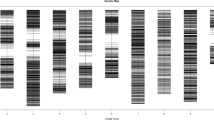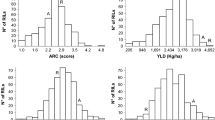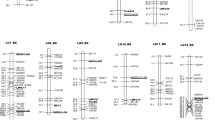Abstract
Seven F2 families of faba bean descendent from plants trisomic for chromosomes 3, 4, 5 and 6 were analyzed for isozyme markers and two of these were also studied for morphological and RAPD markers and seed-protein genes. Linkage analysis revealed 14 linkage groups, 8 of which were unambiguously assigned to specific chromosomes. Several QTLs for seed weight were identified, the most important of which, located on chromosome 6, explained approximately 30% of the total phenotypic variation. Comparison of results from Vicia faba with the maps of the related species Pisum sativum L. and Cicer arietinum L. revealed one possible new case of linkage conservation. A composite linkage analysis based on 42 markers analyzed in this and previous studies, where line Vf 6 was also used as the female parental, allowed the new assignment of previously independent linkage groups and/or markers to specific chromosomes. Thus, the number of linkage groups was reduced to 13, each comprising an increased number of markers. No contradictory results were detected, indicating the suitability of the statistical procedure and methodology used so far in the development of the map of this species.
Similar content being viewed by others
Author information
Authors and Affiliations
Additional information
Received: 30 April 1998 / Accepted: 24 August 1998
Rights and permissions
About this article
Cite this article
Patto, M., Torres, A., Koblizkova, A. et al. Development of a genetic composite map of Vicia faba using F2 populations derived from trisomic plants. Theor Appl Genet 98, 736–743 (1999). https://doi.org/10.1007/s001220051129
Issue Date:
DOI: https://doi.org/10.1007/s001220051129




